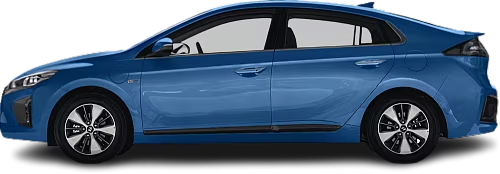Global EV Comparison: Nissan Ariya 87 kWh FWD vs Hyundai Ioniq Electric Gen 1
Struggling to Decide? Let AI Help!
Your AI Summary Is Ready!
General Info
The Nissan Ariya 87 kWh FWD (2021-…) is currently produced, it has a starting price of €53490. The Hyundai Ioniq Electric Gen 1 (2016-2019) has been discontinued. You can find it for as low as €10990 on the used car market.
The Nissan Ariya 87 kWh FWD (2021-…) is a SUV, whereas the Hyundai Ioniq Electric Gen 1 (2016-2019) is a Liftback.
| Property | Nissan Ariya 87 kWh FWD | Hyundai Ioniq Electric Gen 1 |
|---|---|---|
| Years of Production | 2021-… | 2016-2019 |
| Current Status | Produced | Discontinued |
| Country of Manufacture | Japan, China | South Korea |
| Body Style | SUV | Liftback |
| Market Availability | EU, USA | EU, USA |
| Price Europe (New) | €53490 | - Price Europe (New) |
| Price Europe (Used) | €39898 | €10990 |
| GCC Score | 6.4 | 4.8 |
Range and Efficiency
While the Nissan Ariya 87 kWh FWD (2021-…) offers a longer real-world range and a bigger battery, it is less energy-efficient than the Hyundai Ioniq Electric Gen 1 (2016-2019).
| Property | Nissan Ariya 87 kWh FWD | Hyundai Ioniq Electric Gen 1 |
|---|---|---|
| Range (EPA) | 489 km | 200 km |
| Range (WLTP) | 536 km | - Range (WLTP) |
| Range (GCC) | 462 km | 200 km |
| Battery Capacity (Nominal) | 91 kWh | 30.5 kWh |
| Battery Capacity (Usable) | 87 kWh | 28 kWh |
| Efficiency per 100 km | 18.8 kWh/100 km | 14 kWh/100 km |
| Efficiency per kWh | 5.31 km/kWh | 7.14 km/kWh |
| Range and Efficiency Score | 7.4 | 6.2 |
Charging
Both vehicles utilize a standard 400-volt architecture.
The Nissan Ariya 87 kWh FWD (2021-…) offers faster charging speeds at DC stations, reaching up to 130 kW, while the Hyundai Ioniq Electric Gen 1 (2016-2019) maxes out at 69 kW.
The Nissan Ariya 87 kWh FWD (2021-…) features a more powerful on-board charger, supporting a maximum AC charging power of 22 kW, whereas the Hyundai Ioniq Electric Gen 1 (2016-2019) is limited to 6.6 kW.
| Property | Nissan Ariya 87 kWh FWD | Hyundai Ioniq Electric Gen 1 |
|---|---|---|
| Max Charging Power (AC) | 22 kW | 6.6 kW |
| Max Charging Power (DC) | 130 kW | 69 kW |
| Architecture | 400 V | 400 V |
| Charge Port | CCS Type 2 | CCS Type 2 |
| Charging Score | 6.5 | 3.5 |
Performance
Both vehicles are front-wheel drive.
The Nissan Ariya 87 kWh FWD (2021-…) boasts greater motor power and accelerates faster from 0 to 100 km/h.
| Property | Nissan Ariya 87 kWh FWD | Hyundai Ioniq Electric Gen 1 |
|---|---|---|
| Drive Type | FWD | FWD |
| Motor Type | EESM | PMSM |
| Motor Power (kW) | 178 kW | 88 kW |
| Motor Power (hp) | 239 hp | 118 hp |
| Motor Torque | 300 Nm | 295 Nm |
| 0-100 km/h | 7.6 s | 9.9 s |
| Top Speed | 160 km/h | 165 km/h |
| Performance Score | 3.5 | 2.8 |
Dimensions
The Nissan Ariya 87 kWh FWD (2021-…) is longer and taller, but about the same width as the Hyundai Ioniq Electric Gen 1 (2016-2019).
The Nissan Ariya 87 kWh FWD (2021-…) boasts a more extended wheelbase.
| Property | Nissan Ariya 87 kWh FWD | Hyundai Ioniq Electric Gen 1 |
|---|---|---|
| Length | 4595 mm | 4470 mm |
| Width (with Mirrors) | 2172 mm | 2045 mm |
| Width (w/o Mirrors) | 1850 mm | 1820 mm |
| Height | 1660 mm | 1450 mm |
| Wheelbase | 2775 mm | 2700 mm |
Cargo and Towing
The Nissan Ariya 87 kWh FWD (2021-…) features a larger trunk, but the Hyundai Ioniq Electric Gen 1 (2016-2019) offers greater maximum cargo capacity when the rear seats are folded.
Neither car is equipped with a frunk (front trunk).
The Nissan Ariya 87 kWh FWD (2021-…) has a towing capacity of up to 750 kg, whereas the Hyundai Ioniq Electric Gen 1 (2016-2019) is not officially rated for towing in the EU.
| Property | Nissan Ariya 87 kWh FWD | Hyundai Ioniq Electric Gen 1 |
|---|---|---|
| Number of Seats | 5 | 5 |
| Curb Weight | 2121 kg | 1495 kg |
| Cargo Volume (Trunk) | 466 l | 350 l |
| Cargo Volume (Max) | 1350 l | 1410 l |
| Cargo Volume (Frunk) | - Cargo Volume (Frunk) | - Cargo Volume (Frunk) |
| Towing Capacity | 750 kg | - Towing Capacity |
| Cargo and Towing Score | 6.8 | 4.1 |




